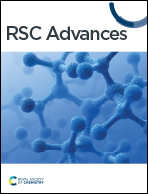Pt nanoparticle dispersed Ni(OH)2 nanosheets via a pulsed laser deposition method efficiently enhanced hydrogen evolution reaction performance in alkaline conditions †
Abstract
The use of electrochemical water is a very attractive and environmentally friendly solution for hydrogen fuel production. Platinum (Pt) catalysts are considered to be the most active catalyst for the hydrogen evolution reaction (HER) but suffer from low efficiency and slow kinetics. Herein, Pt nanoparticles dispersed Ni(OH)2 nanosheets (Pt–Ni(OH)2-X) with different deposition times were designed and developed via a vapour-phase hydrothermal method, followed by a pulsed laser deposition method. The Pt–Ni(OH)2-5 only needs overpotentials of 247.5 ± 43 and 512.5 ± 18 mV to reach current densities of 10 and 100 mA cm−2, respectively, outperforming the commercial Pt/C at a current density of 100 mA cm−2. Furthermore, the infrared spectrum revealed that the adsorption of water molecules becomes stronger at the surface of the Pt–Ni(OH)2-5 nanosheets, and the hydrogen protons overflow onto the Pt surface and facilitate the HER process. This work suggests that moderate Pt nanoparticle dispersed Ni(OH)2 nanosheet help to promote the hydrogen production process.



 Please wait while we load your content...
Please wait while we load your content...